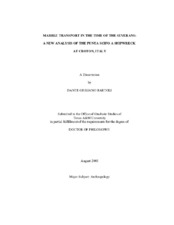| dc.description.abstract | Five ancient shipwrecks have been found in the sea off Croton, in southern Italy,
each carrying a marble cargo composed of massive blocks, column shafts, and smaller
artifacts. Three of them were located while surveying the seafloor with a multibeam
sonar, and the remaining two with the help of divers, in the summers of 2005 and 2006.
Two of the marble carriers are located in the bay of Punta Scifo and, therefore, are
identified as the Punta Scifo A and Punta Scifo B shipwrecks, the remaining three take
their names from the closest promontories: Punta Cicala, Capo Cimiti, and Capo Bianco.
The Punta Scifo A shipwreck was chosen as the main focus of this work because
it contains a unique assemblage of marble artifacts; including 13 basins, 15 stands
decorated with lions’ paws, 16 column shafts, 14 blocks, 6 statue pedestals, and one
statuette of Eros and Psyche. Moreover, because the original discovery dates back to
1908, and in 1915 salvors raised 150 tons of marble artifacts, much information was in
danger of being lost. Consular inscriptions on the Punta Scifo A’s marble blocks and column shafts date the shipwreck to the early third century A.D. The merchantman was
ca. 30 m long and 10 m wide, with a cargo of marble items weighting ca. 200 tons.
The merchantman was loaded with its marble cargo in Asia Minor: all the items
carried on board came from the quarries of Proconnesus and Docimium. The most likely
point of departure was either Epheus or Miletus. While sailing toward the Strait of
Messina, it is likely that a Grecale or Levante storm broke, and the helmsman was forced
to look for shelter in the protected bay of Punta Scifo. Due to a change in wind direction
a southerly Scirocco storm caused the ship to sink. Since the entire coastline south of
Croton is totally unprotected to the south, there was no way for the crew to save their
ship. Where the Punta Scifo A merchantman was destined remains unknown, although
Rome appears to be a likely candidate. | en |


